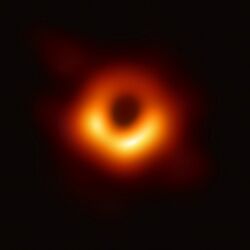Astronomy:CHIRP (algorithm)

CHIRP (Continuous High-resolution Image Reconstruction using Patch priors) is a Bayesian algorithm used to perform a deconvolution on images created in radio astronomy. The acronym was coined by lead author Katherine L. Bouman in 2016.[2][3]
The development of CHIRP involved a large team of researchers from MIT’s Computer Science and Artificial Intelligence Laboratory, the Center for Astrophysics | Harvard & Smithsonian and the MIT Haystack Observatory, including Bill Freeman and Sheperd Doeleman.[4][5] It was first presented publicly by Bouman at the IEEE Computer Vision and Pattern Recognition conference in June 2016.[2]
Development
The CHIRP algorithm was developed to process data collected by the very-long-baseline Event Horizon Telescope, the international collaboration that in 2019 captured the black hole image of M87* for the first time. CHIRP was not used to produce the image,[6] but was an algebraic solution for the extraction of information from radio signals producing data by an array of radio telescopes scattered around the globe.[3][7] Stable sources (that don't change over short periods of time) can also gain signal by integrating the change at each location with the rotation of the earth.[3]:915 Because the radio telescopes used in the project produce vast amounts of data, which contain gaps, the CHIRP algorithm is one of the ways to fill the gaps in the collected data.[8][9]
Evaluation
For reconstruction of such images which have sparse frequency measurements the CHIRP algorithm tends to outperform CLEAN, BSMEM (BiSpectrum Maximum Entropy Method), and SQUEEZE, especially for datasets with lower signal-to-noise ratios and for reconstructing images of extended sources. While the BSMEM and SQUEEZE algorithms may perform better with hand-tuned parameters, tests show CHIRP can do better with less user expertise.[10]
See also
References
- ↑ Overbye, Dennis (April 10, 2019). "Black Hole Picture Revealed for the First Time – Astronomers at last have captured an image of the darkest entities in the cosmos". The New York Times. https://www.nytimes.com/2019/04/10/science/black-hole-picture.html?comments#permid=31473598. Retrieved April 10, 2019.
- ↑ 2.0 2.1 Katherine L. Bouman, Michael D. Johnson, Daniel Zoran, Vincent L. Fish, Sheperd S. Doeleman, William T. Freeman (June 2016). "Computational Imaging for VLBI Image Reconstruction". IEEE Conference on Computer Vision and Pattern Recognition (CVPR) June 2016: 913–922. Bibcode: 2016cvpr.conf..913B. https://www.cv-foundation.org/openaccess/content_cvpr_2016/html/Bouman_Computational_Imaging_for_CVPR_2016_paper.html.
- ↑ 3.0 3.1 3.2 MIT News Office, Larry Hardesty (June 6, 2016). "A method to image black holes". https://news.mit.edu/2016/method-image-black-holes-0606.
- ↑ Shu, Catherine (April 11, 2019). "The creation of the algorithm that made the first black hole image possible was led by MIT grad student Katie Bouman". TechChrunch. https://techcrunch.com/2019/04/10/the-creation-of-the-algorithm-that-made-the-first-black-hole-image-possible-was-led-by-mit-grad-student-katie-bouman/.
- ↑ Brewis, Harriet (April 12, 2019). "Grad student Katie Bouman created the algorithm that led to the first-ever black hole photo". Evening Standard. https://www.standard.co.uk/news/world/mit-grad-student-katie-bouman-algorithm-black-hole-photo-a4114946.html.
- ↑ The Event Horizon Telescope Collaboration (2019). "First M87 Event Horizon Telescope Results. IV. Imaging the Central Supermassive Black Hole. Appendix A: Regularizer Definitions.". The Astrophysical Journal 875 (1): L4. doi:10.3847/2041-8213/ab0e85. Bibcode: 2019ApJ...875L...4E.
- ↑ Science X, News Network (April 11, 2019). "Scientist superstar Katie Bouman designed algorithm for black hole image". PHYS.ORG. https://phys.org/news/2019-04-scientist-superstar-katie-bouman-algorithm.html.
- ↑ Tech Desk, New Delhi (April 22, 2019). "This MIT grad student's work helped make the black hole event horizon image a reality". Express tech, The Indian Press. https://indianexpress.com/article/technology/science/the-image-of-a-black-hole-event-horizon-algorithm-katie-bouman-mit-5669801/.
- ↑ ACM (Association for Computing Machinery), TechNews (June 6, 2016). "A Method to Image Black Holes". http://www.cs.mun.ca/~wlodek/technews/technews-2016/tn-CHIRP-algorithm-16-06-06.html.
- ↑ Kazunori Akiyama, Katherine L. Bouman, Andrew A. Chael, Michael D.Johnson, Sheperd S. Doeleman, Lindy Blackburn, John F. C. Wardle, William T. Freeman and the Event Horizon Telescope Collaboration, Vincent L. Fish (July 2017). "Observing—and Imaging—Active Galactic Nuclei with the Event Horizon Telescope". Galaxies 4 (4): 54 and 64. doi:10.3390/galaxies4040054.
 |

